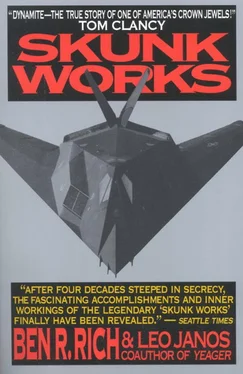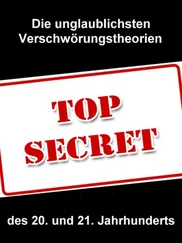Only five of us were cleared for top secret and above, and over the years we had worked on tremendously sensitive projects without ever suffering a leak or any known losses to espionage. In fact, Kelly evolved his own unorthodox security methods, which worked beautifully in the early days of the 1950s. We never stamped a security classification on any paperwork. That way, nobody was curious to read it. We just made damned sure that all sensitive papers stayed inside the Skunk Works.
My biggest worry was clearing our workers for this project. They needed Special Access clearances, and I had to make the case for their Need to Know on an individual basis. But the government, not the employer, was the final arbiter of who was granted or denied access. The Air Force security people made the decision and offered no explanation about why certain of my employees were denied access to the program. No one in Washington conferred with me or asked my opinion or sought my advice. I knew my people very well. Some were horse players, several were skirt chasers, a few were not always prompt about paying their bills. For all I knew some of my best people might be part-time transvestites. I had no doubt that some of the younger ones may have indulged in “recreational drugs,” like toking marijuana at rock shows. Any of these “sins” could sink a valuable worker. I did win a couple of important concessions: the Air Force agreed that only those few technicians with a need to know the airplane’s radar cross section would require the complete full field investigation, which took around nine months, and I was granted temporary clearances for twenty specialists working on particular sensitive aspects of Have Blue. Most important, I raised so much cain that Air Force security finally granted me a “grandfather clause” for many of our old-timers who had been working on all our secret projects since the days of the U-2. They were granted waivers to work on Have Blue.
But security’s dragnet poked and prodded into every nook and cranny of our operation. Keith Beswick, head of our flight test operations, designed a coffee mug for his crew with a clever logo showing the nose of Have Blue peeking from one end of a big cloud with a skunk’s tail sticking out the back end. Because of the picture of the airplane’s nose, security classified the mugs as top secret. Beswick and his people had to lock them away in a safe between coffee breaks. The airplane itself had to be stamped SECRET on the inside cockpit door. I was named its official custodian and had to sign for it whenever it left its hangar area and was test-flown. If it crashed, I was personally responsible for collecting every single piece of it and turning all of it over to the proper authorities.
These draconian measures hobbled us severely at times, tested my patience beyond endurance, and gave Kelly every right to scold, “Goddam it, Rich, I told you so.” At one point I had to memorize the combinations to three different security safes just to get work done on a daily basis. A few guys with lousy memories tried to cheat and carried the combination numbers in their wallets. If security caught them, they could be fired. Security would snoop in our desks at night to search for classified documents not locked away. It was like working at KGB headquarters in Moscow.
The Air Force wanted the two test planes in only fourteen months. Over the years we had developed the concept of using existing hardware developed and paid for by other programs to save time and money and reduce the risks of failures in prototype projects. I worked an agreement with the Air Force to supply me with the airplane engines. They assigned an expediter named Jack Twigg, a major in the Tactical Air Command, who was cunning and smart. Jack requisitioned six engines from the Navy. He went to General Electric’s jet engine division, did some fast talking to the president and plant manager, got some key people to look the other way while he carted away the six J-85 engines we needed right off their assembly line, and had them shipped in roundabout ways, so that nobody knew the Skunk Works was the final destination. We put two engines in each experimental airplane and had a couple of spares. Jack was a natural at playing James Bond: he ordered parts in different batches and had them shipped using false return addresses and drop boxes.
We begged and borrowed whatever parts we could get our hands on. Since this was just an experimental stealth test vehicle destined to be junked at the end, it was put together with avionics right off the aviation version of the Kmart shelf: we took our flight control actuators from the F-111 tactical bomber, our flight control computer from the F-16 fighter, and the inertial navigation system from the B-52 bomber. We took the servomechanisms from the F-15 and F-111 and modified them, and the pilot’s seat from the F-16. The heads-up display was designed for the F-18 fighter and adapted for our airplane. In all we got about $3 million worth of equipment from the Air Force. That was how we could build two airplanes and test them for two years at a cost of only $30 million. Normally, a prototype for an advanced technology airplane would cost the government three or four times as much.
Only the flight control system was specially designed for Have Blue, since our biggest sweat was aerodynamics. We decided to use the onboard computer system of General Dynamics’s small-wing lightweight fighter, the F-16, which was designed unstable in pitch; our airplane would be unstable in all three axes—a dubious first that brought us plenty of sleepless nights. But we had our very own Bob Loschke, acknowledged as one of the very best onboard computer experts in aerospace, to adapt the F-16’s computer program to our needs. We flew the airplane avionically on the simulator flight control system and kept modifying the system to increase stability. It was amazing what Loschke could accomplish artificially by preempting the airplane’s unstable responses and correcting them through high-powered computers.
The pilot tells the flight control system what he wants it to do just by normal flying: maneuvering the throttle and foot pedals directing the control surfaces. The electronics will move the surfaces the way the pilot commands, but often the system will automatically override him and do whatever it has to do to keep the system on track and stable without the pilot even being aware of it. Our airplane was a triumph of computer technology. Without it, we could not even taxi straight.
In July 1976, we began building the first of two Have Blue prototypes in Building 82, one of our big assembly hangars, the size of three football fields. We had our ownunique method for building an airplane. Our organizational chart consisted of an engineering branch, a manufacturing branch, an inspection and quality assurance branch, and a flight testing branch. Engineering designed and developed the Have Blue aircraft and turned it over to the shop to build. Our engineers were expected on the shop floor the moment their blueprints were approved. Designers lived with their designs through fabrication, assembly, and testing. Engineers couldn’t just throw their drawings at the shop people on a take-it-or-leave-it basis and walk away.
Our senior shop people were tough, experienced SOBs and not shy about confronting a designer on a particular drawing and letting him know why it wouldn’t work. Our designers spent at least a third of their day right on the shop floor; at the same time, there were usually two or three shop workers up in the design room conferring on a particular problem. That was how we kept everybody involved and integrated on a project. My weights man talked to my structures man, and my structures man talked to my designer, and my designer conferred with my flight test guy, and they all sat two feet apart, conferring and kibitzing every step of the way. We trusted our people and gave them the kind of authority that was unique in aerospace manufacturing. Above all, I didn’t second-guess them.
Читать дальше












